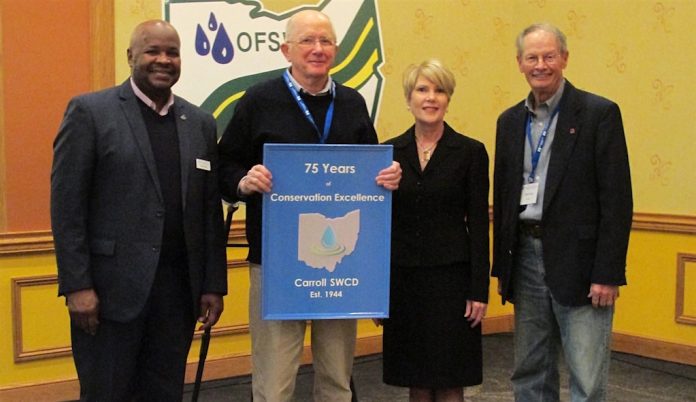
COLUMBUS — Ohio’s new director of the Department of Agriculture, Dorothy Pelanda, told state soil and water conservation leaders that Gov. Mike DeWine and his administration are keeping water quality a top priority across the state, while also pushing the “reset button” on the best approach.
Pelanda spoke at the Ohio Federation of Soil and Water Conservation Districts annual conference Feb. 26 in Columbus, where she announced $24 million in new programs intended to reduce nutrient runoff and improve water quality in the western basin of Lake Erie.
The programs will promote the establishment of year-round vegetative cover, through the Ohio Working Lands Program, and they’ll also promote the development of nutrient management plans, and new equipment designed to reduce nutrient loss.
The funding was approved in S.B. 299, signed into law in October, with the intent of reducing nutrient runoff and the effects of harmful algal blooms in Lake Erie.
Traveling the state
Pelanda said her first few weeks as director have been filled with meet-and-greet events across the state, and that everywhere she goes, the No. 1 priority is water quality.
“My goal is to get out into the agricultural communities, to listen to farmers tell their stories about their histories, their perspectives and their ideas, so that we can move forward,” she said. “I believe that the people closest to the problem are the ones that have the best solutions.”
In 2018, a report by the Ohio EPA showed that farm nutrient runoff was the greatest contributor to phosphorus runoff and algal blooms in Lake Erie, and, acting on the science, the state declared portions of the lake impaired.
A more controversial set of actions developed over the summer and into the fall, when former Gov. John Kasich tried to get eight northwestern Ohio watersheds declared as “watersheds in distress,” and requiring farmers in that area to follow new rules for fertilizer and manure application.
Reviewing rules
Pelanda said the rule package developed by the Kasich administration has been put on “pause,” so the new administration can gather stakeholder input and decide the best course of action. The rules were not popular among farmers and most conservation leaders, who argued they were scientifically unproven and too costly to implement.
Pelanda said the ag department has put the rules in a “to-be-refiled” category, which “neither advances nor stops” the rules from going forward.
“Gov. DeWine has stated that the health of Lake Erie is a top priority of this administration, but he has pushed the reset button to allow all parties involved the opportunity to listen to all stakeholders and determine a way forward that would result in meaningful action,” she said.
Kris Swartz, past president of the Ohio Federation of Soil and Water Conservation Districts, and a farmer from northwestern Ohio, said he’s confident the new programs will make a difference, and be well received by soil and water conservation districts.
“Ohio’s farmers are committed to doing their part to keep nutrients on our fields and out of our water and these programs will help us do that,” he said.
Program details:
- The Ohio Working Lands Program will encourage producers to establish year-round vegetative cover on eligible crop land. The program will promote the conversion, establishment and maintenance of forage/hay land on certain cropland acres. Also, there will be a new incentive payment to encourage producers to re-enroll acreage through the Lake Erie Conservation Reserve Enhancement Program. This will help reach the 67,000-acre goal and increase conservation efforts.
- The Voluntary Nutrient Management Plan Development Program will be a partnership with the Ohio Agribusiness Association, in which producers are reimbursed for soil testing and nutrient management plans. This would help to ensure the 4R principles are put into place.
- The Cost Share and Equipment Buy Down Program will provide producers with funds to purchase technological improvements to agricultural land, equipment and structures to reduce nutrient loss.










Hi Chris, good article. I read about LEBOR and am glad to see a different strategy and approach being sought for. If it’s the phosphorus problem after heavy rain then knowing that is what we need to move forward. Isolating the farms runoff to reuse captured phosphorus and water could also save farms money too!